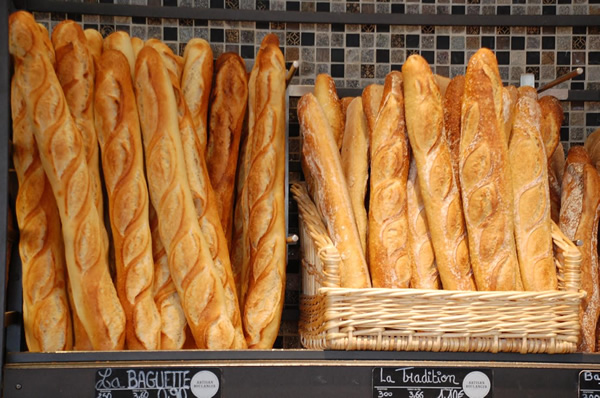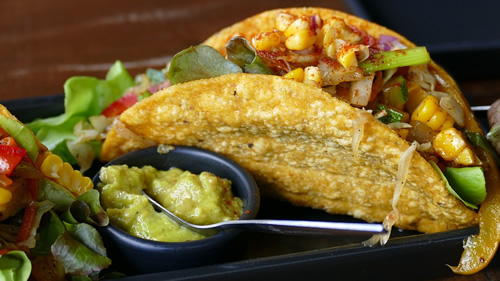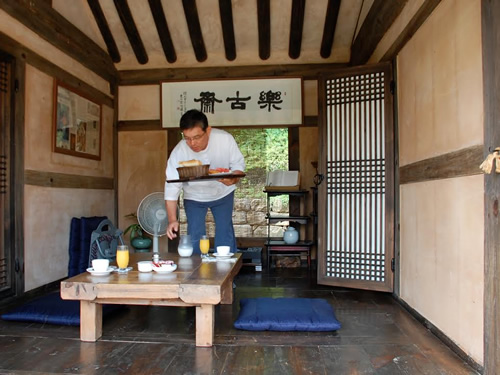Eat Where the Locals Eat
To Find the Best Places to Feast, Ask People Who Live There
By Tim Leffel
 |
Fresh crusty French baguettes made in-house. Few breads smell or taste better.
With fresh butter, cheese, ham, jams, or as an indispensable part of most meals, it is one of the best deals in France as a center or part of a great budget dining experience for the traveler in Paris. Photo by Lies Ouwerkerk. |
As an independent traveler on a budget you’d be wise to steer clear of guidebook recommendations and find your own path. Ask around, wander around, and see where the locals are going. Chances are you’ll
find the best bargain eats as a result.
“Go where the locals go” is not only good advice for your budget. Tourist restaurants are designed for tourists. Too often this means cartoonish versions of the local cuisine — complete with exaggerated
costumes for the waiters — or watered-down versions of dishes that are sure not to offend anyone. The same overpriced westernized food shows up on menus from Chiang Mai to Cusco.
If you eat where the locals do, however, you’ll usually pay their prices and you’ll discover a bit about how they live their life. You can eat banana pancakes and generic pad Thai on Khao San Road in Bangkok
or go one block over and eat real Thai food on sidewalk stools next to the locals.
Cheap but Delicious Dining
Throughout Latin America you always find a simple local lunch restaurant serving something going by one of a dozen names, including comida corrida, merienda, almuerzo economico, or simply el menu. Sit down with the
locals at one of these places and you’ll be served a typical local meal for $2-$4. Maybe a pollo mole poblano (chicken with mole sauce) with rice and tortillas in Mexico, a silpancho (breaded and fried flat beef) with potatoes in
Bolivia, or a paila marina (hearty fish soup) in Chile. You can grab regional versions of tasty empenadas or tacos at a street stall and get recharged for small change.
 |
Eat what the locals eat in whatever country you find yourself. |
Eat at Local Markets
If you eat at a local market, you’ll be getting the freshest food in town, often cooked before your eyes, and you’ll be rubbing elbows with local merchants and shoppers. You’ll be able to learn some
new words and practice the language while getting your fill for cheap. You may have to defy guidebook health wisdom a bit and take some chances, but market and street stalls can actually be safer than restaurants in many countries. The
food doesn’t sit around for days and you can see exactly what the cook is doing.
For the Best Eats, Ask the Locals
How do you find out about the best local places? Ask the people who live there. Most are proud of where they live and are eager for visitors to enjoy themselves. Think about how you would react if a traveler came through
your town and asked you where to go for dinner. Wouldn’t you have lots of ideas based on places you’ve enjoyed?
Of course you do have to consider the source, asking yourself whether there’s a hidden agenda at work. Be wary of taxi drivers who are getting a commission, hotel workers who will send you to the most popular
tourist hangout, or a kindly shopkeeper who is trying to get some bodies into his cousin’s otherwise empty restaurant.
 |
| A street vendor
making cag kebap in Istanbul, Turkey. Photo by Lies Ouwerkerk. |
Observe Local Customs
Pay attention to when and how the local residents eat. North Americans tend to eat earlier than people in many other countries, so some adjustments are necessary, especially in Latin America. Lunch often doesn’t
kick off until around 2 p.m., and it’s rare to see any restaurant filling up for dinner before 9 p.m. If you go much earlier, you’ll be dining alone.
Accept invitations: if someone you feel comfortable with invites you to dinner, treat it as a golden opportunity. Besides the risk of insulting them by refusing, this is a chance to learn about local culture and food.
Some of the most vivid memories of my travels are a big chicken and couscous platter with a family in Morocco, a huge sashimi spread in Japan, and the passing around of a dozen plates with a family in Vietnam.
 |
| Breakfast
on a porch of a Hanok in South Korea. Photo by Lies Ouwerkerk. |
|
Have a Phrase Book Handy
While most guidebooks have a smattering of information about food, it helps to have more to go on. We seldom left the apartment without our phrase book when we lived in Korea and Turkey, and it’s very helpful
to have one in Latin America since an English menu is an oddity. If you have any dietary restrictions, you’ll need to figure out how to talk about them in the local language and understand the cultural hurdles that come with them.
There are also an increasing number of books that dive into a country’s cuisine.
Got Special Dietary Needs?
What if you’re a vegetarian in a meat-happy country? Head to the ethnic neighborhoods. Nearly every country in the world has some Asian restaurants, including most of Latin America. You can find a Chinatown,
Little India, or a Little Saigon offering tasty meals at a bargain price, especially for lunch. Then you can get a view into a whole different culture: expatriates bringing their culture and cuisine to a foreign land.
For More Information on Eating Where the Locals Eat
Editor's Note: Check out TransitionsAbroad.com's section on Culinary Travel: Travel to Eat, which includes many articles by travel writers on visiting countries to taste the local food. Other pieces also demonstrate how to learn to cook local food and learn how it is made by local people and chefs at schools, or more informally often in "food workshops" as guests in their homes or schools.
Given your time and budget, exploring the local food scene as much as possible is always a good idea. While it's tempting for some to stick to popular tourist spots, you are likely missing out on authentic regional home cooking. Our suggestion is to scout out the smaller restaurants until you find one packed with locals, check out if any give you a good vibe, and enjoy.
Imagine staying in a rental with a kitchen and a nearby food market. In that case, it's sometimes possible to recreate dishes yourself when not going out and save some money. (We would not dare to make sushi or certain fried appetizers, chase down an elusive fresh animal, or look for a white truffle.) With the web's infinite reach, it's also possible to find local recipes written up and even illustrated by locals if you enjoy cooking yourself and want to bring culinary knowledge back home.
There are many ways to enjoy the taste of local food made with fruits, vegetables, cheeses, meats, and other fare from the area, which always will have a unique flavor. You name the food, it is almost always better at the place of origin, which is another reason to travel to eat. The founder and family of Transitions Abroad, as have so many of our contributors, have devised entire trips around local food too many times to count!
We always take a chance on local food.
— The Editors
|
Tim Leffel is author of several books, including A Better Life for Half the Price: How to prosper on less money in the cheapest places to live. See more on his Cheapest Destinations Blog.
|
